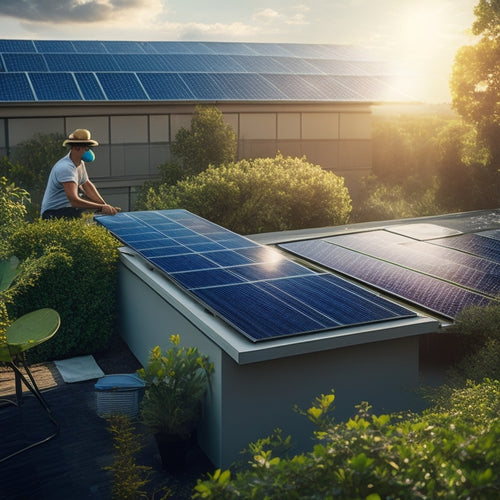
How to Install a Solar Kit in 3 Easy Steps
Share
You'll start by preparing your installation site, conducting a thorough assessment for hazards, inspecting your roof's condition, and taking safety precautions like securing your ladder and wearing personal protective equipment. Next, you'll assemble and mount the kit, determining the best configuration and ensuring a secure fastening to your roof or ground. Finally, you'll connect and test the system, making necessary wiring connections and performing system testing to verify functionality - and that's just the beginning of utilizing renewable energy for your home or business.
Key Takeaways
- Prepare the installation site by assessing potential hazards, inspecting the roof condition, and taking safety precautions.
- Assemble and mount the kit by determining the best mounting configuration and securely fastening it to the roof or ground.
- Connect the solar panels to the charge controller, battery, and inverter, following the manufacturer's instructions and testing the system.
- Ensure proper wiring connections between components, including positive and negative leads, and verify voltage and current readings.
- Perform a thorough system test to verify functionality and identify any potential issues before commissioning the solar kit.
Prepare the Installation Site
Before you begin installing your solar kit, you need to prepare the installation site to guarantee a safe and efficient process. Start by conducting a thorough site assessment to identify any potential hazards or obstacles that could impact the installation. This includes inspecting the roof's condition, checking for any signs of damage or wear, and verifying the structural integrity of the roof.
Next, take necessary safety precautions to prevent accidents and injuries. Ascertain you have a stable and secure ladder, and consider enlisting a spotter to assist you. Wear appropriate personal protective equipment, such as gloves, safety glasses, and a hard hat, to protect yourself from falling objects or electrical shock.
Clear the installation area of any debris, vegetation, or obstructions that could interfere with the installation process. Mark the area where the solar panels will be installed to ascertain accurate placement.
Assemble and Mount the Kit
Now that you've prepared the installation site, it's time to assemble and mount your solar kit.
Begin by unpacking the solar panels, mounting hardware, and tracking system (if applicable). Carefully inspect the components for any damage or defects.
Next, determine the best mounting configuration for your solar panel types. You can choose from various mounting options, including roof-mounted, ground-mounted, or pole-mounted systems.
Consider factors like wind direction, shading, and structural integrity when deciding on the mounting layout.
Verify the mounting system is securely fastened to the roof or ground, following the manufacturer's instructions.
Connect and Test the System
With your solar kit assembled and mounted, you're ready to connect the system. This involves making the necessary wiring connections to guarantee the solar panels, charge controller, battery, and inverter are properly linked. Start by connecting the solar panels to the charge controller, following the manufacturer's instructions for voltage and current ratings.
| Connection | Description |
|---|---|
| Solar Panels to Charge Controller | Connect the positive and negative leads from the solar panels to the charge controller's input terminals |
| Charge Controller to Battery | Connect the charge controller's output terminals to the battery's positive and negative terminals |
| Battery to Inverter | Connect the battery's positive and negative terminals to the inverter's input terminals |
| Inverter to Load | Connect the inverter's output terminals to your desired load, such as an electrical panel or outlet |
Once all connections are made, perform system testing to verify everything is functioning as expected. Check the charge controller's display for voltage and current readings, and verify the inverter is producing a stable output voltage. If everything checks out, you're ready to start generating power with your new solar kit.
Frequently Asked Questions
Can I Install a Solar Kit on a Metal or Clay Tile Roof?
When considering solar installation, you'll face unique challenges on metal or clay tile roofs, requiring specialized mounts and flashing to guarantee a secure fit; however, with the right equipment, you can successfully overcome roof compatibility issues.
How Long Does a Typical Solar Kit Last Before Replacement?
You'll get 25-30 years of energy from your solar kit before considering replacement, with some panels lasting up to 40 years; factor in replacement costs, around $2,500 to $5,000, and plan for a seamless solar lifespan.
Are Solar Kits Compatible With All Electrical Panel Types?
When evaluating solar panel compatibility, you'll find that most kits harmonize with standard electrical panel types, but it's essential to verify your electrical system requirements, ensuring a seamless integration and maximum power output, without compromising your system's integrity.
Do I Need to Notify My Utility Company Before Installation?
Before installation, you'll need to check utility regulations in your area, as some require notification, and obtain necessary installation permits to guarantee compliance, so you won't face any issues with your utility company.
Can I Expand My Solar Kit System in the Future?
Imagine your solar kit as a Lego castle - you can always add more bricks (future upgrades) as long as the foundation (system compatibility) is solid, so yes, you can expand your system as your power needs grow!
Conclusion
You've successfully installed your solar kit in just three easy steps. Don't worry if you're not an electrician - with these instructions, you've bridged the gap. Now, go ahead and flip the switch! If you're thinking "But what about the upfront cost?", remember that the long-term savings and environmental benefits far outweigh the initial investment. Plus, you'll be generating clean energy and reducing your carbon footprint - that's priceless!
Related Posts
-

Solar System Installation Rebates and Tax Credits
Solar system installations offer beneficial rebates and tax credits that greatly cut your initial costs. You can bene...
-

Green Ways to Maintain Solar Panels
To maintain your solar panels sustainably, start with regular inspections to catch potential issues early, enhancing ...
-

Energy-Efficient Heating and Cooling Appliances
Energy-efficient heating and cooling appliances can cut your energy bills markedly. By opting for models with high En...


